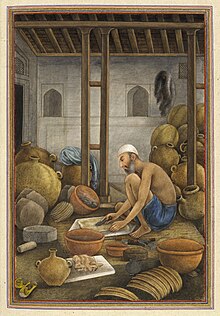Chamar

Leather-bottle makers (Presumably members of the ‘Chamaar’ caste), Tashrih al-aqvam (1825)
|
|
| Regions with significant populations | |
|---|---|
| India • Pakistan | |
| Languages | |
| Punjabi • Urdu • Hindi | |
| Related ethnic groups | |
| other Ramdasia Ravidassia Julaha |
Chamar is one of the untouchable communities, or dalits, who are now classified as a Scheduled Caste under modern India's system of positive discrimination. As untouchables, they were traditionally considered outside the Hindu ritual ranking system of castes known as varna. They are found mainly in the northern states of India and in Pakistan and Nepal.
Ramnarayan Rawat posits that the association of the Chamar community with a traditional occupation of tanning was constructed, and that the Chamars were instead historically agriculturists.
The term chamar has also been used as a pejorative word for anyone whom the describer considers to be of low standing.
According to the 2001 census of India, the Chamars comprise around 14 per cent of the population in the state of Uttar Pradesh and 12 percent of that in Punjab.
In Gujarat they are known as Rohit (caste) and Bhambi Khalpa
The 2011 Census of India for Uttar Pradesh combined the Chamar, Dhusia, Jhusia, Jatava Scheduled Caste communities and returned a population of 22,496,047.
Chamars who have adopted the weaving profession and abandoned tanning and leathercraft, identify themselves as Julaha Chamar; R. K. Pruthi suggests this is in the hope that they might in future be considered as Julaha by other communities in the future.. They believe that leatherwork is "degrading" when compared to weaving.
The Sikh Chamar Ramdasia has a history of military service, including in the Sikh Light Infantry (composed of lower caste- Majhabi and Ramdasia Sikhs).
...
Wikipedia
